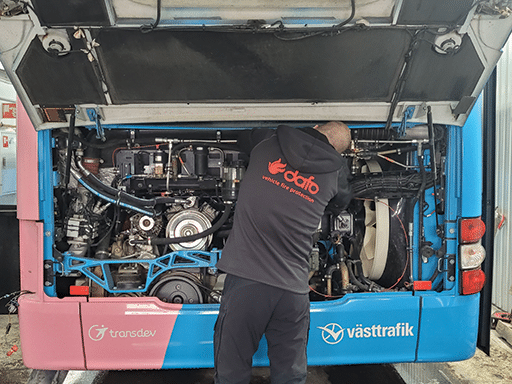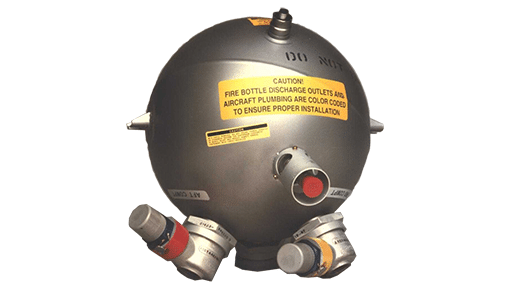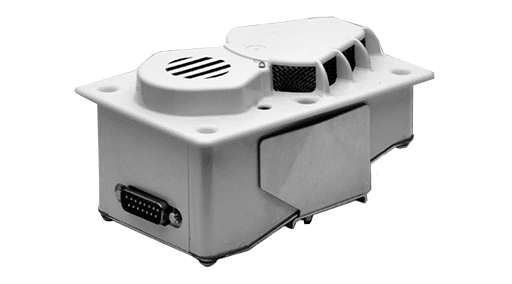Fire detection and alarm systems are ‘must-haves’ for the global transportation industry, both for fixed and moving assets. Here are some standout products being offered by a number of major vendors, as found by Transportation Security International magazine.
Amerex: Detecting Lithium-Ion Battery Fires Early in Electric Vehicles
Lithium-ion battery fires can be devastating to transportation aircraft, ships, and vehicles. As CNN reported when covering a five-alarm fire in New York City believed to have been caused by a lithium-ion battery within an electric scooter, “‘in all of these fires, these lithium-ion fires, it is not a slow burn; there’s not a small amount of fire, it literally explodes,’ FDNY Commissioner Laura Kavanagh told reporters. ‘It’s a tremendous volume of fire as soon as it happens, and it’s very difficult to extinguish and so it’s particularly dangerous.’”
It is for these reasons that early detection of lithium-ion fires matters. This is where the Amerex SafetyNet EV gas detection system can make a difference. According to the company, the SafetyNet EV is ”the only technology that provides early detection of lithium-ion battery fires in commercial electric vehicle fleets.”

Here’s the problem: The lithium-ion batteries being used to propel today’s electric vehicles draw their electricity from multiple onboard power cells. A fire could occur if one or more of these power cells overheat due to charging issues or external/internal damage — potentially causing a thermal runaway event that results in a fire.

The solution: With the Amerex SafetyNet EV gas detection system, sensors are strategically placed in and around the vehicle’s battery compartments. These sensors detect off-gasses emitting from battery cells at trace levels, long before they approach the level of a thermal runaway event. When a danger level is detected, the system sounds an alert that gives the driver time to pull over, leave their vehicle, and dial 911 for help.
“As businesses and municipalities began to increase their investment in electric vehicle fleets, we saw the need to develop the technology to protect people and property,” explained Amerex chief executive officer Harrison Bishop. “Our team worked tirelessly to develop a solution to provide this additional measure of lifesaving detection.”

Bosch: Protecting Airports and Transit Stations
Bosch produces a range of intelligent fire detection solutions for sectors such as airports and transit stations, hospitals, hotels, and industrial/manufacturing facilities. The company’s Avenar line of automatic fire detectors includes smoke detectors for air ducts and open spaces. They also sell flame detectors that can register fires invisible to the naked eye. These include smokeless liquid and gas fires, and materials and substances that emit carbon in their smoke.
“International airports cover hectares of land and comprise not only facilities for air travel, but also connect with train and bus stations, vehicle hire services, hotels and multiple parking lots,” said the company’s website. “A fire at any one of these major activity points could impact all others with a need for evacuation and inspections. Thus, a highly reliable network of fire and smoke detection and alarm systems with PA facilities is needed for efficient response times in case of emergency.”
To prove its point, Bosch cited a fire detection system installation it executed at Cambodia’s Phnom Penh International Airport. “To keep everyone and the building safe from harm and to prevent any service bottlenecks, effective fire protection planning was essential,” said the Bosch website. “Bosch fitted all constructions on the site with a fire alarm system, and special optical and linear-beam smoke detectors, as well as static and moving surveillance cameras. The Public Address and Voice Alarm Systems alert personnel whenever real signs of fire or smoke are detected.”
Dafo Vehicle Fire Protection: Making Bus Passengers and Drivers Safer
Whether they are conventional diesel models or alternative fueled vehicles, buses are vulnerable to fires in their engine compartments. Unfortunately, the speed with which unchecked fires can spread can quickly destroy entire vehicles, while putting the lives of passengers and drivers at risk.
Reducing this risk by extinguishing bus engine compartment fires is the goal of Dafo Vehicle’s fire suppression system. According to Dafo Vehicle’s website, this system consists of four integrated elements; namely Detection, Alarm, Suppression, and Control. All four work together in a coordinated, efficient manner to suppress fires fast. The system’s control unit has a Real-time Clock and Event Log that records and allows access to historical data, so that any previous incidents can be analyzed and addressed.
“The detection system consists of a linear heat detector wire,” said the Dafo website. “It has a fixed temperature sensor with an alarm signal triggered when the activation temperature of 180 C is reached. This signal punctures the burst disc of the propellant gas cartridge, which releases nitrogen into the agent container. The (non-corrosive and environmentally friendly) Forrex liquid is distributed to the nozzles through the pipe system. At the same time, the alarm system is activated, and an alarm horn in the vehicle and a light signal in the panel will warn the driver. The liquid agent will push away the oxygen, cool down the overheated engine parts, impregnate the burning material, stick to surfaces and effectively prevent re-ignition.”
According to Jonas Bergström, the company’s business manager of bus and coach, ”passenger safety is a top priority for Dafo Vehicle. Creating a fire suppression system that combines superior reliability with a valuable low TCO is a challenge that our engineers have solved in an impressive way.”
Fike: Fighting Thermal Runaway Fires with Fike Blue
We have already seen that thermal runaway fires are a real problem in electrical vehicles, or indeed any system that relies on lithium-ion batteries as a power source. This is why a new fire suppression product from Fike Corporation is such welcome news. Fike Blue “is the first solution tested and proven to put out a lithium battery fire by eliminating the cascading thermal runaway event and the possibility of reignition,” said the company website.
Here’s how Fike Blue — a special fluid within a pressurized canister — works. When a fire/heat anomaly is sensed by a third-party detector or a Fike DTS (Distributed Temperature Sensing) cable, the Fike Blue control panel releases the solution into a piping system in the protected area, with the system only opening a nozzle nearest to the heat source. The Fike Blue solution soaks the affected batteries, smothering the fire while extracting its heat.
“With a boiling point of more than 400 C, the liquid absorbs the intense exothermic heat produced from thermal runaway without breaking down,” said FikeBlue.com. “The temperatures for all cells dramatically decrease over the course of several minutes until the event and chance for re-ignition is over.”
At present, Fike Blue has been configured to protect fixed lithium-ion battery banks in renewable energy storage systems, rather than electrical vehicles. However, given its usefulness in stopping thermal runaway events, one can imagine some version of this system being developed for the EV market as well. In the interim, airports and other transportation facilities that use lithium-ion power storage would be wise to give Fike Blue some consideration. It is apparently a real solution to a problem that dogs the lithium-ion sector.
FireFlex Systems: Detecting and Dousing Class B Fires
Class B fires are the ones that involve flammable gasses and/or liquids linked to propane, natural gas, gasoline, kerosine, petroleum greases, tars, oils, oil-based paints, solvents, lacquers, or alcohols. These are extremely dangerous fires that can’t be doused by water, which simply spreads the flames around. This is why Class B fires in garages and hangars are often extinguished using pre-installed Compressed Air Foam (CAF) systems. Sprayed throughout the affected area, CAF is created by combining air, water and foam concentrate to generate and dispense a homogeneous foam solution that is physically similar to shaving cream.
FireFlex Systems makes Class B fire detection and dousing systems that are well-suited to the transportation industry. In the latter category, FireFlex’s “ICAF compressed air foam system is FM Approved as a local application extinguishing system for class B pool fires, spill fires and cascading fires,” according to the company’s website. According to this company, “ICAF uses four times less water and up to six times less foam concentrate compared to foam-water systems.” This makes it economical to use as well as effective.
When fires do occur, it is vital for firefighting crews and evacuating personnel to be able to see what’s happening on the fire scene. According to FlexFlex, CAF’s “unique physical properties significantly reduce steam production” when compared to conventional water-based extinguishing systems, ensuring better visibility during and after a fire. The reason? The CAF blankets the fuel surface, thus not causing “the visual impairment often associated with high-expansion, total flooding foam systems.”
Honeywell: Providing Self-Testing Smoke Detectors
Smoke detectors are an essential element of any fire detection system. However, these devices can only do their jobs if they are fully functional. Ensuring that they are requires ongoing testing by building operators, which can be a very demanding task if the spaces being protected are large and equipped with numerous smoke detectors.
Fortunately for airport and transit station operators, Honeywell has addressed this problem with a fire alarm system that comes with UL-approved self-testing smoke detectors that can be tested automatically. The NOTIFIER INSPIRE fire alarm system with self-test detectors is an all-in-one fire system designed to deliver reliable protection, efficient monitoring, and easy expansion, in addition to flexible and timely reporting. These detectors report to Honeywell’s Connected Life Safety Services (CLSS) cloud-based platform, to make system monitoring and troubleshooting possible from remote locations.
“Honeywell is integrating intelligence across all aspects of fire and life safety systems,” said Jurgen Van Goethem, Honeywell’s president of Fire Life Safety Systems. “By digitizing the most essential system in the building, we’re creating efficiencies during commissioning and maintenance, we’re further improving system reliability and we’re improving the end-user experience. We’re also working to change building owners’ mindsets to think about fire and life safety systems not just as a necessary system to be able to occupy the building, but as a system with a wealth of data that going forward, we can tap into to ultimately better protect lives. This will help move the industry toward the creation of safer and more compliant buildings.”
Worth noting: NOTIFIER INSPIRE’s modular design makes it easy to add new fire detectors as buildings are expanded. Meanwhile, these units’ self-testing features are so sophisticated, that they introduce small amounts of heat and smoke into their own detection chambers to check their photo and thermal sensors, along with verifying that their smoke entry points are unobstructed.
Johnson Controls: Addressable Fire Detection for Small Watercraft
Fire detection is as important on small boats as it is on large ships. This is why Johnson Controls has released the Zettler T1306, which the company bills as “the first addressable alarm panel … specifically developed for use within small-scale marine vessels.” According to this company, using addressable technology allows mariners to quickly and clearly pinpoint fire locations in their vessel, speeding up response times while allowing muster protocols to be tightened up.
“With the global maritime industry quickly evolving and experiencing a phase-out of conventional fire alarm control units, our customers need an approved fire panel that offers the latest addressable technology with the quality and reliability they expect from Zettler products,” said Paul Grainger, product manager with Johnson Controls Fire Detection Products. “This new panel not only provides addressability and reliability at a competitive price, it also simplifies installation and maintenance and contributes to a low lifecycle cost.”
Capable of supporting audible and visual alarms, the T1306 is equipped with two full-powered loops. These can be split into six shared power loops, which are capable of connecting up to 500 sensing devices in total. The alarm panel can be located within the bridge, or remotely coupled to this command center using an in-bridge repeater to save space. It features an easy-to-understand LCD display, plus robust controls that can withstand harsh marine environments.
The T1306 comes with a 24-hour battery capacity, has built-in fail-safe capabilities and comes with advanced control panel technologies that reduce false alarms. It also offers a top and bottom entry gland plate, communication via Modbus to gateway (SMS/MIS), and a four-panel capacity when installed in a master/client configuration. The T1306 fire alarm panel has an IP32 rating and has attained various global industry approvals such as EN54, MED, ABS, BV, DNV GL, KRS, LRS (IACS) and CCS.

Kidde Technologies: Keeping Aircraft Safe
Fire in an aircraft is a terrifying possibility that offers deadly consequences. Passengers and pilots can’t evacuate at 30,000 feet. This is why Kidde Technologies makes a number of fire suppression products aimed at keeping aircraft safe. It starts with a range of fire suppression hardware that employ single and multi-outlet spherical, cylindrical or radial tubular containers to hold liquid extinguishing agents, which are made from durable stainless steel or titanium. This product range also includes solid propellant-based suppression devices and dedicated electronic modules for system monitoring and control. These modules can be configured to be manually controlled by the crew, or activated automatically when fire conditions are detected.

Fires in aircraft lavatory washrooms, caused by people smoking and then throwing still-lit cigarettes into waste bins, are a serious threat to aircraft in flight. This is why Kidde makes a Lavatory Waste Bin Extinguisher to address this danger. Available for Boeing and Bombardier aircraft, these units use proven, existing hardware to fight waste bin fires as soon as they exceed a temperature of 170 F (77 C). When this threshold is crossed, the Lavatory Waste Bin Extinguisher releases inert nitrogen under pressure through its discharge nozzles, over a period of three and five seconds.

Kidde also makes advanced photo-electric smoke detectors for aircraft cabins and lavatories, which can be installed without any changes to aircraft cabin/lavatory structures or existing wiring. According to the company, these smoke detectors are compliant with environmental legislation, use dual-wavelength technology to minimize false alarms due to “nuisance aerosols” and provide improved fire detection capabilities even at high altitudes.
